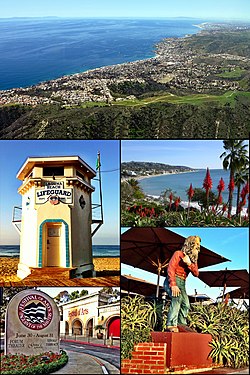Laguna Beach, California
| Laguna Beach, California | ||
|---|---|---|
| City | ||

Images from top, left to right: Laguna Beach coastline, Lifeguard Tower, view from Heisler Park, Festival of the Arts, and statue of Town Greeter Eiler Larsen.
|
||
|
||
 Location within California and Orange County |
||
| Coordinates: 33°31′53″N 117°46′9″W / 33.53139°N 117.76917°WCoordinates: 33°31′53″N 117°46′9″W / 33.53139°N 117.76917°W | ||
| Country |
|
|
| State |
|
|
| County |
|
|
| Founded (post office) |
1887 | |
|
Incorporated (city) |
June 29, 1927 | |
| Government | ||
| • Type | Council-manager | |
| Area | ||
| • Total | 9.821 sq mi (25.435 km2) | |
| • Land | 8.850 sq mi (22.921 km2) | |
| • Water | 0.971 sq mi (2.515 km2) 9.89% | |
| Elevation | 20 ft (6 m) | |
| Population (April 1, 2010) | ||
| • Total | 22,723 | |
| • Estimate (2013) | 23,250 | |
| • Density | 2,300/sq mi (890/km2) | |
| Time zone | Pacific (UTC−8) | |
| • Summer (DST) | PDT (UTC−7) | |
| ZIP codes | 92651, 92652 | |
| Area code | 949 | |
| FIPS code | 06-39178 | |
| GNIS feature IDs | 1660874, 2411595 | |
| Website | lagunabeachcity |
|
Laguna Beach is a seaside resort city located in southern Orange County, California, in the United States. It is known for a mild year-round climate, scenic coves, environmental preservation, and artist community. The population in the 2010 census was 22,723.
Historically a territory of Paleoindians, the Tongva people and then Mexico, the location became part of the United States following the Mexican–American War. Laguna Beach was settled in the 1870s, officially founded in 1887 and, in 1927 its current government was incorporated as a city. In 1944, the city adopted a council-manager form for its government. The city has remained relatively isolated from urban encroachment by its surrounding hills, limited highway access, and a dedicated greenbelt. The Laguna Beach coastline is protected by 5.88 miles (9.46 km) of state marine reserve and an additional 1.21 miles (1.95 km) of state conservation area.
Tourism is the primary industry with an estimated three million people visiting the community annually. Annual large events include the Pageant of the Masters, Festival of the Arts, Sawdust Art Festival, Art-A-Fair, Bluewater Music Festival, and Kelpfest.
Laguna Beach was the habitation site of a prehistoric paleoindian civilization. In 1933, the first fossilized skull of a paleoindian found in California was uncovered during construction on St. Ann's Drive. Known as "Laguna Woman", the skull originally was radiocarbon dated to more than 17,000 BP, however, revised measurements suggest it originated during the Holocene era 11,700 years before present. Subsequent research has found several prehistoric encampment sites in the area.
Historically, the indigenous people of the Laguna Beach area were the Tongva. Aliso Creek served as a territorial boundary between Gabrieleno and Acjachemen groups, or Juanenos, named by Spanish missionaries who first encountered them in the 1500s. The area of Laguna Canyon was named on an 1841 Mexican land grant map as, Cañada de las Lagunas (English:Glen of the Lagoons). After the Mexican-American War ended in 1848, the area of Alta California was ceded to the United States. The treaty provided that Mexican land grants be honored and Rancho San Joaquin, which included north Laguna Beach, was granted to José Antonio Andres Sepúlveda. Following a drought in 1864, Sepúlveda sold the property to James Irvine. The majority of Laguna Beach was one of the few parcels of coastal land in Southern California that never was included in any Mexican land grant.
...
Wikipedia

